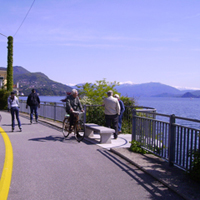For a Safer City. And Friendly. And More Beautiful.
Abstract
For many years the security of mobility in the city has been considered as a crucial social subject because of the high number of the victims and, more generally, of its impact on the life conditions in the city. The above-said subject, indeed, if rightly set out, shows important and basic implications regarding the quality of urban life, since the citizen – and the weak user of the road in particular - is strongly limited in the use of urban public spaces. Besides, those spaces are a basic element of the city structure: in fact from ancient times the city has been considered mainly for its attitude to allow social relationships. And that can be achieved only if the urban public spaces are fit for it, as regards quantity but above all as regards quality. Consequently, there is an increasing attention to acquire methods, techniques and strategies to face the planning, building and management of roads, squares and urban green areas (mainly according to the logic of recovering the historic and consolidated city) aiming at making citizens fully use the city. The subject is on the agenda of those Countries which pay more attention to social questions and of consequence, in a laudable way, to the real quality of urban places, meant as spaces with high functional level mainly targeted to people aggregation as well as to outdoor activities in general. Therefore, the subject itself is an opportunity of reconstituting the urban and regional planning discipline (and, generally speaking, of the city’s disciplines) starting from the renewed interest in the public spaces. That is the most significant and expressive meaning of the term “friendly city”, which really highlights the target of security connected with that of the effective usability of urban environment. The subject will acquire then a further value if it includes also the territorial dimension. The soft mobility (i.e. pedestrian and cycle)strongly affects the long distances too, involving also the extra-urban ambit. As regards this, the lay-outs of historic roads can be effectively utilized, if they are still in use, by making restricted interventions. An example of that is given by the towpaths of (natural and artificial) streams and sites of vacant railway stations. The report deals with the above mentioned statements and introduces supporting elements and examples, with reference also to the implications on urban landscape. On the one hand, the city looks prettier when interventions are carried out to re-qualify public spaces, which produce non banal aesthetic improvements too. On the other hand, above all, the possibility of moving slowly, on foot or by bicycle, allows to perceive the complexity of urban and territorial landscape in its composition of several visual plans and components, which otherwise would be impossible.Downloads

Copyright (c) 2014 Tema. Journal of Land Use, Mobility and Environment

This work is licensed under a Creative Commons Attribution 4.0 International License.
Authors who publish in this journal agree to the following:
1. Authors retain the rights to their work and give in to the journal the right of first publication of the work simultaneously licensed under a Creative Commons License - Attribution that allows others to share the work indicating the authorship and the initial publication in this journal.
2. Authors can adhere to other agreements of non-exclusive license for the distribution of the published version of the work (ex. To deposit it in an institutional repository or to publish it in a monography), provided to indicate that the document was first published in this journal.
3. Authors can distribute their work online (ex. In institutional repositories or in their website) prior to and during the submission process, as it can lead to productive exchanges and it can increase the quotations of the published work (See The Effect of Open Access)
